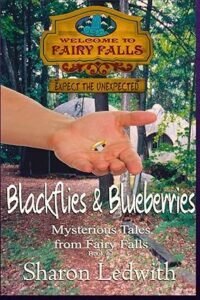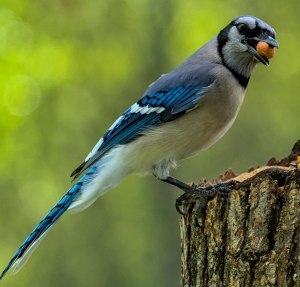C.D. Hersh's Blog
November 13, 2025
Friday Feature Welcome To Fairy Falls
Don’t Forget to Pack the Bug Spray…
 In book two of Mysterious Tales from Fairy Falls, Blackflies and Blueberries, I wrote about Hart Stewart—a teenage psychometrist who has no problem ‘reading’ the absorbed energy from an object like a ring or watch but struggles with the most basic reading skills. He finds a ring that pulls him into the past to witness a woman’s murder that has gone unsolved for over a year. That woman was Diana MacGregor’s mother, and when Diana discovers that Hart is in possession of the ring and shares the intimate details of her mother’s murder through his psychic ability, Diana strikes a deal with him. She’ll teach Hart how to read and write if he helps find her mother’s killer.
In book two of Mysterious Tales from Fairy Falls, Blackflies and Blueberries, I wrote about Hart Stewart—a teenage psychometrist who has no problem ‘reading’ the absorbed energy from an object like a ring or watch but struggles with the most basic reading skills. He finds a ring that pulls him into the past to witness a woman’s murder that has gone unsolved for over a year. That woman was Diana MacGregor’s mother, and when Diana discovers that Hart is in possession of the ring and shares the intimate details of her mother’s murder through his psychic ability, Diana strikes a deal with him. She’ll teach Hart how to read and write if he helps find her mother’s killer.
Blackflies & Blueberries, Book 2; Mysterious Tales from Fairy Falls
 The only witness left to testify against an unsolved crime in Fairy Falls isn’t a person…
The only witness left to testify against an unsolved crime in Fairy Falls isn’t a person…
City born and bred, Hart Stewart possesses the gift of psychometry—the psychic ability to discover facts about an event or person by touching inanimate objects associated with them. Since his mother’s death, seventeen-year-old Hart has endured homelessness, and has learned ways to keep his illiteracy under wraps. He eventually learns of a great-aunt living in Fairy Falls, and decides to leave the only life he’s ever known for an uncertain future.
Diana MacGregor lives in Fairy Falls. Her mother was a victim of a senseless murder. Only Diana’s unanswered questions and her grief keeps her going, until Hart finds her mother’s lost ring and becomes a witness to her murder.
Through Hart’s psychic power, Diana gains hope for justice. Their investigation leads them into the corrupt world threatening Fairy Falls. To secure the town’s future, Hart and Diana must join forces to uncover the shocking truth, or they risk losing the true essence of Fairy Falls forever.
Excerpt
For over a year now, Diana had wondered, prayed, and longed for any information regarding her mother’s murder. And now this guy shows up, who claims he has these psychic powers that can communicate with objects. Objects like mom’s ring. Diana pressed her lips together. An object that had been there, at the scene of the crime, a viable witness to a heinous act. It all seemed so far-fetched, so out there. Yet what did Hart have to gain from all this? This wasn’t a fortune telling session, this was real. So was Hart for real?
“Who are you, anyway?” Brook asked. “The sorcerer’s apprentice?”
Hart threw her a strange look. “No. My name’s Hart Stewart. I’m Gertie Ellis’s great-nephew.”
Diana snapped out of her self-induced trance. Gertie Ellis? Not the same Gertie Ellis who was Dan Boone’s only alibi? No. This is all too much. It was information overload to the power of ten. Diana thought she heard Donovan mumble ‘Uh-oh’ as he took a step back. He swung the golf club behind his back, as if anticipating her next move, but Donovan would have never have guessed what was about to happen next, because what came out of her mouth shocked even Diana. “Name your price, I’ll pay you whatever you ask. You can even have my car, if you want it.”
Donovan dropped the golf club.
Brook gasped.
Hart snapped his head back. “Pay me? Pay me for what?”
“To find my mother’s killer,” Diana replied. “Let’s face facts. You’re the only person who has these special psychic connections and no one else has been able to solve her murder. Look, I’ve got all the information on my mother’s murder, I’ve kept impeccable files, know the suspects, and can help you get anything you’d need. What do you say?”
“Your…your car?” Donovan muttered.
“Are you sure you want to do this?” Brook asked, concerned.
Diana held her hand out toward Hart. “Do we have a deal?”
Dumbfounded, Hart looked at Diana’s offered hand, then glanced back to her face, searching for a hint of sincerity. He nodded. “I’ll help you, if you help me.”
Startled, Diana arched her thin, fair brows. “Help you? How?”
Hart took a deep breath. “My mother was murdered too. In Toronto, just over a year ago, in our apartment. Nothing was taken. She had no enemies to speak of and we weren’t rich. All I have is a letter my great-aunt kept from when mom was my age. Maybe it will help answer some questions, maybe it won’t.”
Diana nodded. “So what does it say?”
Hart cast his eyes to the ground. His face reddened, his hands balled at his sides. He took another deep breath. “I…I don’t know,” he replied, his voice cracking. “I can’t—”
Diana inclined her head. “Can’t what?”
Hart’s eyes locked with Diana’s. His chin trembled as he whispered, “Read.”
Silence, except for the sudden, chilly gust of wind coming off of the lake.
Donovan broke it. “Dude, did you just that say you can’t—”
“Donovan!” Brook elbowed him in the ribs. “Don’t be so insensitive!”
Donovan rubbed his side, and nodded. “Dude, you’re illiterate?”
Brook rolled her eyes. “That’s not what I meant, you bonehead.”
Diana ignored her friends and got straight to the heart of the matter. “Then I’ll teach you to read. We’ll help each other. That way, I’ll get what I want, and you’ll get what you want.”
Blackflies & Blueberries, Book Two Buy Links:
PANDAMONIUM PUBLISHING HOUSE ׀ AMAZON ׀ BARNES & NOBLE ׀
Here’s a glimpse of the premises of both my young adult series:
The Last Timekeepers Time Travel Adventures…
Chosen by an Atlantean Magus to be Timekeepers—legendary time travelers sworn to keep history safe from the evil Belial—five classmates are sent into the past to restore balance, and bring order back into the world, one mission at a time.
Children are the key to our future. And now, they are the only hope for our past.
Mysterious Tales from Fairy Falls Teen Psychic Mysteries…
In the small, quiet tourist town of Fairy Falls, a new-to-town teen, an unlikely hero who possesses an unusual psychic ability, is drawn into a mystery and is tasked with uncovering corrupt truths that threaten the town’s future.
Welcome to Fairy Falls. Expect the unexpected.
Buy Links:
The Last Timekeepers Time Travel Adventure Series:
The Last Timekeepers and the Noble Slave, Book 3
UNIVERSAL BUY LINK ׀ AMAZON ׀ BARNES & NOBLE ׀
The Last Timekeepers and the Dark Secret, Book 2 Buy Links:
UNIVERSAL BUY LINK ׀ AMAZON ׀ BARNES & NOBLE ׀
The Last Timekeepers and the Arch of Atlantis, Book 1 Buy Links:
UNIVERSAL BUY LINK ׀ AMAZON ׀ BARNES & NOBLE ׀
Legend of the Timekeepers, Prequel Buy Links:
UNIVERSAL BUY LINK ׀ AMAZON ׀ BARNES & NOBLE ׀
Mysterious Tales from Fairy Falls Teen Psychic Mystery Series:
Lost & Found, Book One Buy Links:
PANDAMONIUM PUBLISHING HOUSE ׀ AMAZON ׀ BARNES & NOBLE ׀
Blackflies & Blueberries, Book Two Buy Links:
PANDAMONIUM PUBLISHING HOUSE ׀ AMAZON ׀ BARNES & NOBLE ׀
 Sharon Ledwith is the author of the middle-grade/young adult time travel adventure series, THE LAST TIMEKEEPERS, and the award-winning teen psychic mystery series, MYSTERIOUS TALES FROM FAIRY FALLS. When not writing, reading, researching, or revising, she enjoys anything arcane, ancient mysteries, and single malt scotch. Sharon lives a serene, yet busy life in a southern tourist region of Ontario, Canada, with her spoiled hubby, and two shiny red e-bikes.
Sharon Ledwith is the author of the middle-grade/young adult time travel adventure series, THE LAST TIMEKEEPERS, and the award-winning teen psychic mystery series, MYSTERIOUS TALES FROM FAIRY FALLS. When not writing, reading, researching, or revising, she enjoys anything arcane, ancient mysteries, and single malt scotch. Sharon lives a serene, yet busy life in a southern tourist region of Ontario, Canada, with her spoiled hubby, and two shiny red e-bikes.
Learn more about Sharon Ledwith on her WEBSITE and BLOG. Look up her AMAZON AUTHOR page for a list of current books. Stay connected on FACEBOOK, TWITTER, LINKEDIN, INSTAGRAM, and GOODREADS.
BONUSES:
Download the free PDF short story The Terrible, Mighty Crystal HERE
Download the free PDF writing resource Tips, Tools & Tricks for the Tenacious Writer HERE
November 11, 2025
Wednesday Special Spotlight Music in your writing
We went to a concert put on by a local symphonic group. One of the pieces the orchestra played was Dream of a Soldier by Edward Santoro, a WWII army soldier who was a musician and band director. The piece is filled with pathos and emotions—pain, suffering, joy, pride, passion—that Santoro saw reflected in the faces of the soldiers he encountered during the war.

The music reminded us of the underscores one hears in the movies. The crashing sounds of intense, emotional buildup. The rich, melodious strains that support beautiful love scenes. The dissonant, harsh minor chords that underlay pain-laden story events. We heard every emotion played so clearly on the orchestra instruments that it felt like we were being taken on an emotional rollercoaster.
If you’ve ever watched a movie you’ll realize that even though you might not consciously hear an underscore of music (unless the volume is so overwhelming that one has to stuff their fingers in their ears), the music provides a subtext that enriches the story and pulls listeners toward an emotion that the director wants us to experience.
After the concert, ever the dissecting writers that we are, we began to wonder if writers apply the musical underscore concept to novel writing. What do we use that stirs the reader like the music in a movie stirs the viewer?
To underscore something means to accentuate it, to call attention to it, to emphasis or highlight. Music underscores do this in a fashion that supports the text the actors are saying or the actions they are performing. Because it’s visual and audible the two things work together quite well.
Our musical underscores are the language we use, the details in the scenes that we set, and the internal insight we provide for our readers. Some writers might call this adding depth. This depth or, musical underscore writing as we’re calling it, is the difference between a book that reads flat, versus the richness of a manuscript that has internal narrative, sensory elements, and setting. For the written word, however, providing nuances that enrich and support the words on the page isn’t as simple as adding a single element such as music, since words are more one dimensional than movies or television. To draw our readers in we need sensory information, emotional content, inner dialogue and ramped up tension.
To give you an idea of what we mean, here is an example that illustrates musical underscore writing. This is a piece of a scene from one of our Turning Stone Chronicles book without the musical underscore.
Hugh jammed the cell phone and the handgun into LJ’s free hand. “Hurry. Get to the safe room. I’ll hold them off as long as I can. Don’t come out until I, or Mike, if he gets here in time, come to get you.” He kissed the top of the baby’s head and then grabbed his wife and held her close. “I’m sorry. This is all my fault. I should have been able to protect you two better. Hidden us where he would never find you. Find the baby.”
“You did the best you could, Hugh. Don’t blame yourself.” She kissed him and then ran toward the basement staircase for the safety of the hidden, steel panic room.
Hugh shouldered the vest of explosives he’d prepared and wheeled around for one last look at his family. When LJ reached the top of the steps, she turned and gasped.
“You’ll be safe in the panic room. I swear. The explosion won’t penetrate there.”
“Come with us,” she pleaded.
“They won’t stop unless they believe us dead. There’s no other way.”
She stood absolutely still.
Hugh waved her toward the staircase. When she’d left, he picked up the kill switch and turned to face the assassins he knew advanced.
Great setup here. We know killers are coming for them. We know Hugh is probably a bad ass, and that help is on the way. We can figure out from his actions that he probably loves his wife and the baby and that he’s feeling guilty about what is happening. We also know from her request that LJ probably loves Hugh, and she doesn’t want him to die. This paragraph could stand on its own, but, as it reads now, there is no emotional connection that the reader can grab on to. There’s nothing to force the reader to care about the characters and want to see what happens. No crescendo swells of music to tug on the readers’ hearts. Nothing but the basic information you need to tell part of the story.
Now let’s add some musical underscoring to this scene. The original text is bolded so you can see how musical underscore writing adds depth that tugs on your hearts.
Hugh jammed the cell phone and the handgun into LJ’s free hand. Her flesh was as cold as the metal of the magnum pressed against her palm. For a moment he wondered if she would actually fire it. Damn! He should have seen this coming and taken her to the pistol range so they’d be more prepared. He pressed her unwilling fingers around the weapon.
“Hurry.” His voice cracked, and he struggled to keep it strong for her. “Get to the safe room. I’ll hold them off as long as I can. Don’t come out until I or Mike, if he gets here in time, come to get you.”
He kissed the top of the baby’s head and then grabbed his wife and held her close, committing the feel of her to his memory. Was she doing the same? Because if he was right, he wasn’t going to survive tonight. Gazing into her eyes, he saw the depth of her fear. The baby’s chin started trembling as he caught his mother’s anxiety. LJ started shivering, too. He pulled them tighter in his embrace, unwilling to let them go, but knowing he must.
“I’m sorry. This is all my fault. I should have been able to protect you two better. Hidden us where he would never find you. Find the baby.”
“You did the best you could, Hugh. Don’t blame yourself.” She kissed him, and he felt the electricity of her passion surge through him. It gave him strength for what lay ahead. Strength to die for them. Strength to kill the men who were coming.
Reluctantly, he released her, and she ran toward the basement staircase for the safety of the hidden, steel panic room.
Hugh shouldered the vest of explosives he’d prepared and wheeled around for one last look at his family. When LJ reached the top of the steps, she turned and gasped. Her brown eyes rounded, dark pools of apprehension shining from her pale face.
“You’ll be safe in the panic room. I swear. The explosion won’t penetrate there.”
“Come with us,” she pleaded. She started toward him.
He motioned her back, the expression on her face nearly undoing in his resolve. Could they run one more time? Find someplace where they would be safe? At his hesitation her face brightened and she took another step in his direction.
“Don’t, LJ. We have to make a stand here and now. They won’t stop unless they believe us dead. There’s no other way.”
She stood absolutely still as disbelief, terror, anguish, and, finally, love, swept over her face.
The emotions flooded the room, nearly choking him with their intensity. Hugh waved her toward the staircase. When she’d left, he picked up the kill switch and turned to face the assassins he knew advanced. They would not take his family. Not as long as he had breath left in his body.
In this version we’ve added emotions, lots of emotions, because this is a highly emotional scene. There’s no need for much setting here, because we’re not trying to set a scene. It’s obvious from the words such as basement staircase and panic room that we are probably in the couple’s home. What we want to do here, in this highly charged scene, is grab the readers’ hearts and make them turn the next page to see who survives. We want them to ask, “Will Hugh survive? Will he actually blow himself up to protect his family? Or will the cavalry arrive in time to save everyone?” We want them to wait breathlessly for the next crashing crescendo of music to carry them farther into the story.
So what’s the easiest way to tell if you’ve added musical underscores? Try writing the dialogue first. Get the basic ideas and direction of your scene in place, then go back over the scene and reread it. If it’s a scene that needs setting, add that first. Then layer in some of the senses: taste, touch, sight, smell, and auditory senses. Next add emotions. Sprinkle in inner thoughts where appropriate. Then make sure you have the tension on the page that Donald Maas advocates.
If you tend to write your musical underscores the first time around, go back and double check that you have put the right things in the right amounts into your scene. A highly charged scene, such as a love scene, shouldn’t have a lot of back story dropped in, unless it’s relevant to something that starts or stops the emotional rollercoaster of a love scene. Don’t stop an action scene to have the character reminisce about how he got in this predicament. There will be time for that if he survives. When the setting is important to the scene, be sure and add the elements you need to create that dark and stormy night, or the peek at the rich and famous, or whatever you might be trying to set with your scene. Don’t neglect the senses, either. Smell, touch, and what we hear are three powerful senses that can transport the reader into your story in a matter of seconds. And above all, remember, you want to grab the reader, not overwhelm them with purple prose.
So, the next time you sit down to write, imagine a musical underscore for your scene, and compose the music with the things you know best—words.
How do you add your musical underscores in your books?
November 10, 2025
Tell Again Tuesday Fictional Truth
What is Truth in Fiction? By Donald Maass

It’s an absurd question. Fiction is made up, an invented and exaggerated show of human experience. Any “Truth” it presents isn’t grounded in science or ethics, but might be better deemed any individual writer’s idea of what has veracity.
And what, in the first place, do we mean by Truth? An objective, verifiable, always-the-case rendering of the human condition? Realism? Indisputable facts? A pointing finger? A strong moral assertion or religious persuasion? A message, lesson, or theme? Aphorisms, truisms, or platitudes? Common sense?
One thing is certain, writers . . .
For the rest of the blog go to:November 6, 2025
Friday Feature Tell it to the Marines
We love the wonderful world of clichés. From the time we are babes in the bosom of our family to a ripe old age to the final days when we are six feet under, we are inundated with clichés. They conjure up vivid images, some that make sense and others that don’t. We all can identify with someone being in the same boat (we’re in it together) or flog a dead horse (it’s useless). But what about she eats like a bird? It’s meant to say a person doesn’t eat much, but have you ever watched birds? They eat all the time.

A lot of the phrases can make a long story short when you’re trying to explain yourself to a sea of faces, especially if you don’t have a leg to stand on regarding whatever you’re explaining. A shrug and the excuse the best laid plans of mice and men or accidents will happen can often get us off the hook. Clichés can help us roll with the punches, make short work of our writing or pass the time of day. We can put a bee in our heroine’s bonnet and give her butterflies in her stomach or bury that hatchet in the victim’s back and keep the perp who did a number on him cool as a cucumber. You can politely excuse yourself by going to see a man about a horse (or a dog). As long as you don’t come back with the aforementioned animals everyone will know you went for a potty break.
Let’s face it, clichés have a vise-like grip on most of us. We sprinkle them in our speech and in our writing when we want to make a quick point that doesn’t need explaining. After all, who doesn’t know what tired as a dog or apple pie order or wreathed in smiles means? We have a hard time turning over a new leaf and finding new idioms because we’re so in touch with those old as the hill phrases. How many times have you set your heart on an expression to only have your critique partners hack it to bits like it was a snake in the grass? That just adds insult to injury, especially when all those clichés are a labor of love.
As strange as it seems, our love of clichés isn’t going to win us our spurs with editors and agents. They may use clichés when they speak, like the rest of us, but they don’t think they’re worth the paper they’re written on. Using clichéd writing won’t help us pay the piper, keep the wolf from the door, make us rich as Croesus or get us the red carpet treatment. What it will do is rub editors the wrong way and make them beat a hasty retreat, which will cause our manuscripts to bite the dust and plunge us to the depths of despair when we are rejected, and that will put us between a rock and a hard place…if you know what we mean.
So here’s a word to the wise … avoid those cans of worms like the plague before they get a chance to take the wind out of your sails. Gird up your loins, put on your thinking cap and wash your hand of those clichés. Rid your writing of ugly ducklings in favor of a few, fresh as a daisy, well-chosen words that will rock the editors’ world, and you’ll be a roaring success. Would we lie to you?
If you think this post is too funny for words, leave us a few—words, that is—fresh or old. After all, we do love clichés…believe you me.
What is your favorite cliché?
November 4, 2025
Wednesday Special Spotlight – To Market, to Market
It’s years since the release of our first book in the Turning Stone Chronicles and we’ve learned a lot more about marketing than we ever thought we would need to know. Our marketing knowledge didn’t get our books to the best seller list, but the way we look at it is that knowledge is power. And, hey, if we keep following all the market tips we come across, we can always hope for the big sales, right?

For those who are just starting on their book journey, here are seven things we’ve learned that we think are extremely important, especially for writers who are considering signing on with smaller presses with smaller marketing budgets or self publishing.
• Don’t wait until the editor asks for your book to start figuring out how to market. Search the internet for book review sites and virtual blog tour sites and decide on a plan. Look for blog sites and review sites that have large audiences. The more exposure you give your book, the better the chances of a sale.
• Build your social media before you sell the book. We resisted Facebook, Twitter, Goodreads and all the social media things out there. When the editor said, “We want all the authors involved in social media,” we had such a steep learning curve that it became overwhelming and all consuming.
• Don’t be shy about telling others about your book. Look for every outlet to work it into a conversation, as naturally as possible, of course. You don’t want to come off looking like an idiot by shoving a business card in their hands if they show absolutely no interest. We’ve handed our book cover business cards out to people at Colonial Williamsburg while researching info for another book, to the workers at the post office, to our doctor and dental hygienist when they asked what was new in our life. We’ve even considered leaving a couple on the restaurant table with the tip. And we have.
• Let your friends and family work for you as your street gang. Give them book swag (postcard, business cards, flyers or whatever kind of promo materials you are passing out) so they can reach people you would never meet.
• Consider joining group blog sites to reach a different demographic than your blog reaches. After we signed on with our publisher, we joined the publisher’s author group and posted there on a rotational basis. We also looked for other sites that were of interest to us and asked to join or guess post.
• Don’t neglect your own blog when your book comes out. There are some who are saying that writers shouldn’t blog because it takes away from the writing time, and that’s so true. On the other hand, when you have an ebook, you are plugged into the electronic world where most of the marketing is happening. It can be a time drain, but you need to figure out how to handle it.
• There is also those who recommend you start a newsletter. Again, a writing time drain but many swear by it as a way to get a group that will be interested in your book. Have a sign up link on your blog site or keep a pad of paper where they can sign up when you attend a conference or book signing.
These seven items are just the tip of the marketing iceberg, they don’t cost anything but time, and are, we believe, invaluable. So, tell us, what are you doing to market your published book or to get ready to market your WIP?
November 3, 2025
Tell Again Tuesday Ouch that hurts!
10 “Notes to Self” for Those Times When You’re Taking Things PersonallyBy Angel Chernoff

Let’s start off here with a simple question:
Why do we always take things personally?
There are admittedly quite a few valid reasons to consider. But the one Marc and I have found to be most common through 15 years of working with our coaching clients and live event attendees is . . .
For the rest of the blog go to:October 30, 2025
Friday Feature The Curse of Continuity
 You’ll hear writers complain about the number of typos that get missed during the editing and proofreading processes, so their work is published with errors it is too late to fix. This is something that happens to even the most well-known authors, regardless of what publisher they use.
You’ll hear writers complain about the number of typos that get missed during the editing and proofreading processes, so their work is published with errors it is too late to fix. This is something that happens to even the most well-known authors, regardless of what publisher they use.
As a proofreader who is also an author, I have seen typos in my own published work and have no idea how I missed them. There is some kind of brain glitch that sees what it expects to see, hence, for example, ‘to’ becomes ‘do’, and the meaning of an entire sentence is lost. We just have to hope that readers suffer from the same glitch or like our work enough to overlook the mistakes.
Proofreading errors are bad enough, but far worse are errors in continuity and these may be harder to spot. For example, a character may sit at a table while having already done so on the previous page; someone claims to have come by bus, yet we know he left his car in the car park; the protagonist is shown into the boss’s office by a blonde secretary who is a redhead when he comes out.
I have just finished editing a book I wrote over several years. It started as three novellas which were then glued together into one novel. Revisiting old material is a challenge anyway but more so when a book has been written in sections with not enough thought to the sequence of events. Continuity errors have been a nightmare with this particular work, and chunks of the narrative had to be rewritten to iron out the inconsistencies. Proofreading errors, conversely, have been a doddle.
While storytelling is an author’s main function, there are many other factors that must be borne in mind. An author must:
Create interesting, believable characters that the readers will care aboutProvide them with a plotline that worksWeave any necessary subplots seamlessly into the narrativeBe fluent and grammatically correct in the language of their choiceAvoid spelling and style errors and typosCreate a consistent atmosphere to suit the genre of the workDo sufficient research to support the credibility of the workDecide if certain themes, social commentaries or observations are to be includedMaintain the interest of the readers throughout, regardless of their demographic, andNever disappoint their readers with weak endings and plot holes.While juggling all of the above, continuity might slide under the radar, but an author must keep track of what their characters are doing: their movements; appearance; clothes; dialogue; relationships; backstories; ages; emotions, and so on. Added to that is the need to be aware of changes in time and place.
That’s a lot of plates to keep spinning! No wonder errors creep in.
Alas, after you’ve written and submitted your book and you’re sure you’ve created perfection, you might see one of those plates smashed on the ground when a continuity error is finally discovered—but it’s too late, because your book’s been published! A case in point is the book I am currently reading. It’s well written and compelling and the author is prolific and professionally published; however, I noted that the main character asked someone if they had any kin, to be told no, only to ask that same person the same question two pages further on, again with the same response. Given all those spinning plates the author had to keep an eye on, I’d say it happens to the best of us.
Here is a brief intro to Book One of Carol’s exciting trilogy.
 Banished from Elvendom and forced to seek refuge among the Saxons, young Elgiva faces a grim future – until she crosses paths with Godwin, a Briton enslaved by the people she must now call allies.
Banished from Elvendom and forced to seek refuge among the Saxons, young Elgiva faces a grim future – until she crosses paths with Godwin, a Briton enslaved by the people she must now call allies.
When a dark power rises to claim dominion over Elvendom, Elgiva and Godwin set off on a dangerous quest for the legendary Lorestone: the only thing that can stop the looming darkness. With a reluctant elf boy as their guide and a stubborn pony by their side, they must navigate the treacherous land and harness ancient magic before it’s too late.
As battle lines are drawn, Elgiva must embrace her true heritage, and Godwin must learn to wield the secret power he possesses. But can they find the Lorestone in time – or will Elvendom fall forever?
A historical fantasy adventure set in 6th century Britain, THE EXILE OF ELINDEL is the first book in Carol Browne’s The Elwardain Chronicles series.
 Once upon a time a little girl wrote a poem about a flower. Impressed, her teacher pinned it to the wall and, in doing so, showed the child which path to follow.
Once upon a time a little girl wrote a poem about a flower. Impressed, her teacher pinned it to the wall and, in doing so, showed the child which path to follow.
Over the years poems and stories flowed from her pen like magic from a wizard’s wand.
She is much older now, a little wiser too, and she lives in rural Cambridgeshire, where there are many trees to hug.
But inside her still is that little girl who loved Nature and discovered the magic of words.
She hopes to live happily ever after.
October 28, 2025
Wednesday Special Spotlight For a Spook Factor Choose a Halloween Setting
If you’re looking for a setting for your paranormal book, take a look at October 31st—Halloween. It’s a spooky, ancient celebration where darkness reigns. And in a paranormal book, darkness can be important. 
In our series The Turning Stone Chronicles, Halloween is an important date for the shape shifters. Samhain, aka Halloween, is the day when the magic rings, which allow the characters to shift, become bound to them. If they are in possession of a ring after midnight on Samhain, only one thing can separate them from the ring’s magic—DEATH!
Halloween is not only a combination of ancient Druidic practice and pre-Christian Roman and Celtic religious beliefs, but the date on which it falls is an important church feast day for Roman Catholics, Anglicans, and Lutherans. Interestingly enough, there are pagan (now considered secular) elements in most of our Christian holidays: the Easter bunny, Easter eggs, mistletoe, yule logs and holly.
Most people aren’t even aware of the pagan roots of the aforementioned things. But the idea that evil reigns on Halloween is not uncommon. Ghosts, goblins, vampires and the like roam the streets of our subdivisions every October 31st. Even though the Church tried to stop the spread of Samhain’s pagan rituals by placing Christian feast days on the same days as pagan celebrations, it failed with Halloween. The spooky things we associate with Halloween could not be wiped out.
All those spooky notions, creepy characters, and pagan rituals that have come down through the centuries can be used in your paranormal book’s settings. Use them as they are, or put your own twist on them like we did. Don’t think paranormal can be scary? If that’s what you believe, take a stroll past, or in, a cemetery on a full moon when the clouds passing over the old, white gravestones flicker like ghostly forms. To make it creepier, take the walk after you’ve watched a werewolf or vampire movie. Catherine had to pass by a huge cemetery at night on her way home from the movies when she was a teenager. (We did a lot more walking at night back then than kids do now.) Even though she didn’t believe in ghosts and the like, when she walked alone she ran the whole mile clutching her cross necklace, singing hymns in her head, and praying nothing from the grave would chase her home. Spook factor? You bet!
Originally celebrated as an end-of-year ritual by the ancient Celts, Samhain was not only “thanks” to their sun god Baal for the harvest but a time when the lord of the dead gathered and decided the fate of deceased souls. The spirits of the dead were believed to have permission to visit their living relatives briefly on October 31, the eve of Samhain, to obtain warmth and comfort for the cold winter ahead. Some of these spirits would also play pranks and wreak havoc with supernatural happenings.
To prevent the spirits from taunting them or their animals, the Celts would hang blessed bells around the necks of their cows and light new fires by rubbing branches of the sacred oak together. These bonfires would scare away the malicious ghosts, yet provided guiding lights for the more kindly ones who wanted to visit family. We’re still wrapping our head around that one, since it doesn’t make much sense to us that fire would only scare some of the ghosts.
In A.D. 43 the Romans conquered the Celts and added their own touches to the October 31st celebrations, which included fortune-telling with the use of fruits and nuts as the means to divine the future. During this time two more autumnal festivals were combined with the Celtic festival of Samhain. Later the descendants of the Celts—the Scottish, Irish, and English—added their rituals to the celebrations.
In the fourth century, when the Christian Church was declared lawful by Roman Emperor Constantine, the church tried to discourage the pagan rituals and moved their feast honoring all the saints from May to November. About a hundred years later, Pope Gregory IV decreed that All Hallows Eve would be moved to October 31. The Druidic Lord of the Dead festival became a Christian festival in hopes that, by allowing the church’s new followers to continue a feast on a date celebrated before becoming Christian, the church could expunge the pagan traditions.
But try as they might, the church was unable to completely erase the remnants of the ancient Celtic holiday. Over the years the rituals moved from religious to secular, and for much of the population, these aspects of the Celtic holiday remained part of every October. Thanks to the descendants of the Celts—the Scottish, Irish and English—the macabre reigns on Halloween. Magic, witches, devils, demons, ghosts, goblins, and a host of other dark, scary things rule every October 31st . . . and more often if you read or write paranormal.
What about you? Have you ever used a Halloween aspect in something you’ve written?
October 27, 2025
Tell Again Tuesday Easy fall food
TEXAS COWBOY STEW! YUM!!! by Cheryl PiersonBy Cheryl Pierson

Fall’s on the way, so it’s time for some good recipes to fix on those cool evenings. I’m thrilled to find recipes that are EASY, QUICK, and GOOD. Have you ever noticed how many times cowboys in films and books sit down to a hearty bowl of stew?
Growing up, my mom made a lot of vegetable soup, but never made stew. I don’t know why, because I have seen my dad eat stew elsewhere, but for some reason, Mom just never did make it. I learned to make it . . .
For the rest of the blog go to:October 23, 2025
Friday Feature Savory Holiday Treat
The holidays are just a few weeks away. It’s time to start gathering recipes for those fun times in your home and your contribution to the parties you’ll soon enjoy. Here’s a super easy appetizer that will make everyone toast you and want to keep eating.
Addictive Cheeseball
 2 – 8 oz. pkgs. cream cheese, softened
2 – 8 oz. pkgs. cream cheese, softened
6 oz. corned beef*
5 green onions
1 tsp. (5ml) garlic powder, not salt
1 tsp. dried dill weed
1 tbsp. Worcestershire sauce
Place cream cheese in a medium-sized mixing bowl. I know this seems too large, but you need the room. Use a wooden spoon to mash the cheese against the sides of the bowl.
Chop the meat then stir into the cheese.
Slice onions into small pieces, be sure to include a lot of green, then stir into cheese mixture.
Sprinkle on garlic and dill. Stir well. Taste for flavor. Add more garlic if necessary but go easy.
Blend in Worcestershire sauce.
Scoop onto a sheet of cling wrap, then form it into a ball, and refrigerate. Remove from fridge a half hour or so before serving. This dish lasts 1 week in the fridge.
When you’re ready to serve, place the unwrapped cheeseball on a plate then surround it with crackers. Sociables or any baked savory cracker works best.
*Deli corned beef is wonderful in this recipe. Ask the clerk to slice the meat thin. Tear the meat into small pieces when you’re ready to make the cheeseball.
In a hurry? Use packaged corned beef and be sure chop the meat before adding to cheese mixture.
May you enjoy all the days of your life filled with good friends, laughter, and seated around a well-laden table!
Sloane
 Sloane Taylor is an Award-Winning romance author with a passion that consumes her day and night. She is an avid cook and posts new recipes on her blog every Wednesday. The recipes are user friendly, meaning easy.
Sloane Taylor is an Award-Winning romance author with a passion that consumes her day and night. She is an avid cook and posts new recipes on her blog every Wednesday. The recipes are user friendly, meaning easy.
To learn more about Taylor go to her website. Stay in touch on Blogger, Twitter, and LinkedIn.
Taylor’s cookbooks, Hot Men Wear Aprons, Date Night Dinners, Date Night Dinners Italian Style, Sizzling Summer, and Recipes to Create Holidays Extraordinaire are released by Toque & Dagger Publishing and available on Amazon.



